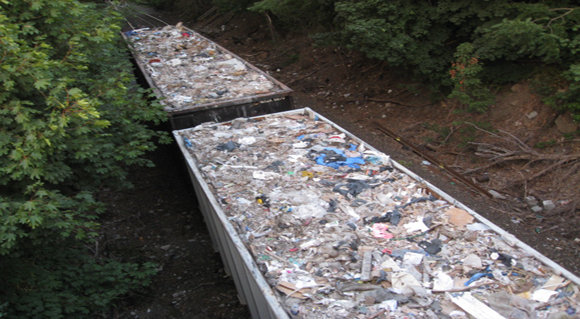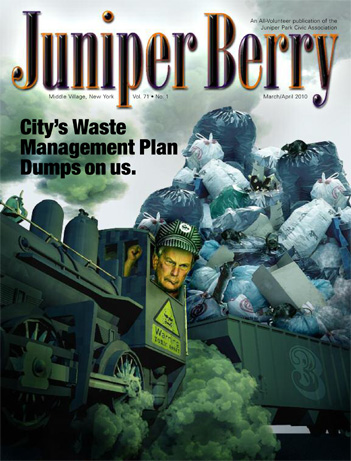Western Queens’ civic associations united in November 2009 to work for the upgrade of freight rail transportation and the environment. The name of the new coalition is CURES: Civics United for Railroad Environmental Solutions. The coalition was formed specifically to address rail problems at a point where the transport of solid waste by rail has escalated community burdens to intolerable levels. The coalition’s Co-Chairs are Mary Parisen and Mary Arnold, next-door neighbors in Glendale who live across the street from the Fresh Pond Terminal rail yard. Parisen and Arnold started the current campaign to upgrade the freight rail system with the Glendale Clean & Green campaign that kicked off in September 2009.
After an initial organizational meeting organized by Brian Dooley and Dolores Capace of the Glendale Property Owners Association, CURES’ first meeting took place on December 8, 2009, in the cafeteria of Christ the King Regional High School. At that meeting, elected officials and their staffs and CURES leaders agreed to hold a series of five fact-finding and policy meetings with more stakeholders to find solutions to existing problems. Participants decided that the meeting topics would be: 1. Solid Waste, 2. Emissions & Idling, 3. Hazmat, Homeland Security & Public Safety, 4. Noise, 5. Local Infrastructure.
Solid Waste
CURES organized the Solid Waste meeting, which took place on February 3, 2010, in the Queens Borough President’s conference room. 32 stakeholders — representing three railroads, elected officials and agencies at every level of government, a private sector waste management company, and CURES — participated in the 90-minute meeting. The meeting gave all stakeholders an opportunity to express their perspectives on the situation, how it developed, and what opportunities might exist for improvements. At the close of the meeting, in response to a question from CURES, Les Fiorenzo, Region 1 Administrator for the Federal Railroad Administration (FRA) stated that CURES’ concerns were valid, that assembled stakeholders needed to address the issues of containerization and movement of solid waste, and also indicated that it was a situation that the FRA itself might be considering.
As the article by Middle Village residents Anthony Pedalino and Laura Zimmer in this same issue of the Juniper Berry shows, the new problems created by these waste trains have drained utility, enjoyment, and value out of private property in the rail corridor. For example, in response to concerns expressed by Queens Community Board 5, the Federal Railroad Administration measured noise levels from trains in the area above 88 decibels. Because of this very loud noise, residents’ sleep is regularly disrupted.
In response to questions from CURES leaders at the February 3rd meeting, we learned that waste containers used in freight rail transport are never washed. In response to another question from CURES, we were told by a private sector waste management company representative that problems residents are experiencing were not anticipated in the environmental impact review process. Residents who can’t eat outdoors and enjoy their yards when stinking garbage containers are on adjacent tracks are wondering why these problems were not anticipated or disclosed before a 20-year contract was signed to process up to 950 tons of Brooklyn garbage a day and haul all of it by rail through their neighborhood in Queens.
Impact on the Community
For homeowners near the rail corridor, it is as though pieces of distant waste processing plants landed in their formerly peaceful residential area as their new neighbors. This new phenomenon of freight rail transport of waste has brought the problems of odors, noise, and vermin that were anticipated for the plants right into the heart of neighborhoods, miles away from the plants. Before these problems hit Middle Village, they were happening at Christ the King, which had to litigate to get relief.
The civics in CURES came together because we could see that these problems were simply being pushed from one community to another. What CURES wants to see instead are stakeholders coming together to devise and implement new solutions that take into account and reduce community impacts on a system-wide basis. At the February 3rd meeting CURES urged new methods of containerization and changes in waste transport operations. The people who were in the room have the knowledge and power to make changes that relieve neighborhood burdens. Without new solutions, CURES leaders are very concerned that these serious problems will blight communities from LI City to LI because of the volumes of waste.
The Message is Clear
CURES message to elected officials, agencies at every level of government, and the businesses that handle the waste is that the costs of communities must be taken into account as they make their calculations for balanced budgets, profitable operations, green transportation, and economic development. In the past, community costs have been reckoned at zero. CURES is telling those with the power to change things that this is untrue and unjust. At the Feb. 3rd meeting CURES pointed out that economic and transportation development models that value community costs at zero, factor in garbage as a NYC “product,” and drain value out of neighborhoods are short-sighted and unsustainable.
Railroads Need Upgrades
The longstanding attitude that Queens’ communities have to take whatever comes from the railroad corridor also has to change. Why? Well, for one thing there is new technology and funding available and CURES wants to see that Queens gets its fair share. Warren Buffet bought a railroad because the rail business is in a renaissance. The railroads need to innovate and invest for the good of their own businesses. Other communities and railroads have obtained substantial federal funds for upgrades that greatly leverage private funding. CURES wants to see public-private partnerships developing projects that bring money for upgrades into Queens.
Why are these upgrades to reduce diesel emissions needed when the railroads tell us that more transport by rail – even using old locomotives — takes trucks off the road, thus lowering diesel emissions? What isn’t mentioned as often is that for people living near the rail corridor, running more trains using old diesel engines means breathing diesel pollution with increased risks of adverse health impacts. Also, everyone has to do their part to lower emissions for the sake of public health and the environment. That is why freight rail is subject to the new 21st C. Clean Diesel regulations under the federal Clean Air Act and why the federal government has offered funding to effect upgrades and reduce emissions.
In a 2009 Clean Air Task Force, Inc. national air quality survey, Queens County was ranked 27th out of 3,109 (where 1 was worst) counties nationwide, and given a grade of “F” in particle pollution by the American Lung Association. This failing grade means that Queens’ bad air quality is putting more than a million Queens’ residents with chronic diseases — including emphysema, diabetes, asthma, and cardiovascular disease – at risk. New York State is designated a nonattainment” area by federal Clean Air Act standards, in part because of diesel emissions.
New technology can reduce these problems and lower the cost of railroad operations at the same time. It’s a win-win situation when state-of-the-art repowering technology replaces locomotive engines that were brand new back in the 1970’s.
To the credit of the railroads, NYS Department of Transportation, the city, and US EPA, the railroads have secured funding to install another new technology — anti-idling equipment — on locomotives owned and leased by NY & Atlantic Railway. However, US EPA has gone on record in response to CURES leaders’ concerns to say that repowering is still needed, even with the anti-idling technology. CURES is waiting for our elected officials to go to bat for repowering grants that will provide cleaner, healthier air for the people of Queens.
Where does CURES go from here? William Goetz, Resident VP of CSX, said that the railroads want to hear all community concerns so that they can be comprehensively addressed. So as the discussions about Solid Waste continue, CURES already has started organizing the second stakeholders meeting to explore solutions for Idling and Emissions issues. CURES Co-Chair Mary Parisen said it best in her welcoming remarks at the February 3rd meeting: “We might not see eye to eye on everything, but we want to understand this complicated issue and discuss some possible solutions. CURES wants to help the railroads secure grant money from our government for the upgrade of equipment. We hope and expect your help with the issues our communities are facing.”
How can you help CURES? If your civic is not already a member, please join us! Contact us at civicsunited @gmail.com. Contact your elected officials and attend meetings of your local civic association and community board. Express your concerns by talking with your neighbors, showing up at meetings, writing a comment to the newspaper, speaking up. Do what you can. A tsunami of waste on rail cars is headed for Queens. Individual voices alone have not been effective. United together we are making a difference!
If you are on the internet, join facebook and become a friend and fan of CURES. Spread the word! Invite friends in your networks and others who may be interested to become friends and fans. You can post comments, photos, even videos. You will receive information and updates. Go to facebook and search for “CURES – Civics United for Environmental Railroad Solutions.”
CURES Mission Statement
Civics United for Railroad Environmental Solutions — CURES — is a coalition of 13 civic associations from Maspeth, Middle Village, Ridgewood, Glendale, Elmhurst, Woodside, Forest Hills, and Woodhaven — all communities along the local railroad corridor. CURES believes that increased railroad traffic is coming as both a cost-saving and environmentally sound measure.
However, our organization is dedicated to ensuring that this increase in railroad traffic does not come at a cost of increased environmental burdens for our communities. Our communities already are suffering from noise, the stench of garbage left sitting on sidings for long periods of time, health-threatening diesel emissions from outdated locomotives, and security threats from easy access to rail yards that store dangerous cargo, such as liquefied petroleum gas.
Therefore, we pledge to work with federal, state, and local agencies, our elected officials, and the railroads themselves to lobby for funding to retrofit old diesel locomotives to reduce their polluting emissions and cut back on idling; to ensure that the rail yards themselves are free of hazards and threats to neighborhood health and security; and that the railroads are proactively utilizing cleaner technologies and new controls in an efficient and responsible manner for the good of their own businesses as well as the health and welfare of our neighborhoods and NYC.
CURES Members – February 2010
Citizens for a Better Ridgewood
COMET
Farmers Oval Civic Association
Forest Hills Cooperatives
Glendale Civic Association
Glendale Clean & Green
Glendale Property Owners Association
Juniper Park Civic Association
Liberty Park Home Owners
Maspeth/Middle Village Task Force
Maspeth West End Civic Association
New Ivanhoe Civic Association
Ridgewood Property Owners Association




